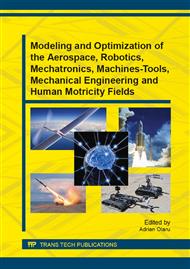p.26
p.32
p.40
p.49
p.57
p.66
p.72
p.78
p.84
A New Kalman-Type Approach for Satellites Attitude Determination
Abstract:
This paper presents a Kalman type method for attitude determination of satellites. It is shown that the linearized model describing the satellite kinematics may be expressed as a stochastic system corrupted with both additive and multiplicative white noise. For this class of stochastic models a hybrid Kalman filter is used to estimate the quaternion expressing the satellite attitude and the bias of the inertial measurement unit. By contrast with the classical Kalman filters, the hybrid filter used in this paper includes a continuous-time and a discrete-time component. The advantage is that it may provide a time varying estimation of the states between the sampling moments which usually are sparse in space applications. The theoretical developments is illustrated via a numerical case study.
Info:
Periodical:
Pages:
57-65
Citation:
Online since:
June 2014
Authors:
Price:
Сopyright:
© 2014 Trans Tech Publications Ltd. All Rights Reserved
Share:
Citation:


